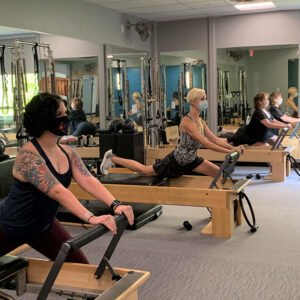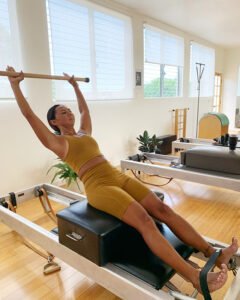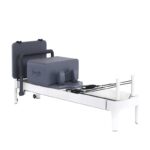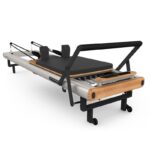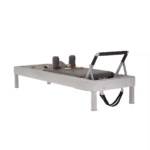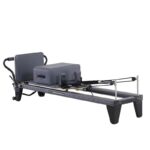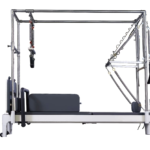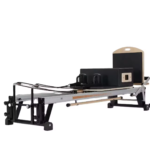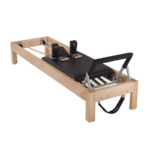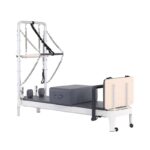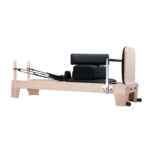The spine is the central axis of the human body, supporting the body’s weight and protecting important nerve tissue. However, factors such as sedentary lifestyles, poor posture, and aging can lead to spinal problems such as scoliosis and back pain. As a full-body training method that emphasizes core strength and body symmetry, Pilates has shown unique advantages in improving spinal health. This article will explore the functions of the Pilates Spine Corrector, whether Pilates can realign the spine, how it helps spinal curvature problems, and which Pilates exercises are best for strengthening overall spinal strength. At the same time, we will also introduce how to choose the right Pilates equipment for the home environment.

The role of the Pilates Spine Corrector
The Pilates Spine Corrector is a small auxiliary tool designed to strengthen the back muscles and improve spinal flexibility. It is shaped like an arched wooden box and is covered with soft cushions. By performing various stretching, bending, and twisting movements on the corrector, users can effectively stretch tight muscle groups, increase the range of motion between spinal joints, and promote good posture. This equipment is particularly useful for those who want to relieve back discomfort caused by holding the same posture for a long time.
Can Pilates realign the spine?
While Pilates itself does not directly change the bone structure or “realign” the spine, it does support better spinal alignment by strengthening the relevant muscle groups. When the core muscles become stronger, they can better support the spine, thereby reducing pressure and helping to maintain correct body posture. In addition, regular targeted Pilates exercises can also help correct some minor spinal deviations caused by muscle imbalances. Therefore, it can be said that Pilates is very effective in preventing and improving mild to moderate spinal problems.

Pilates Helps with Spinal Curvature
For people with scoliosis or other forms of abnormal curvature, appropriate Pilates exercises can help to a certain extent. This type of training focuses on strengthening the muscles on the weaker side, loosening the tight side, and promoting balanced development of strength on both sides through specific movement patterns. For example, classic movements such as “single leg extension” and “hundred taps” are good choices. However, it should be noted that before starting any new exercise program, especially for existing spinal problems, it is best to consult a doctor or physical therapist to ensure the safety and suitability of the selected exercise program.
The best overall spine strengthening exercise
Among the many Pilates movements, “swimming” is considered to be particularly helpful in strengthening the entire spinal area. This movement simulates the alternating arm and leg movements during swimming, requiring practitioners to lie on the mat, lift their limbs a few inches off the ground, and then quickly swing their arms and legs in sequence. This can not only effectively activate the deep back stabilizer muscles, but also improve the strength of the muscles around the shoulders and hips. Of course, in addition to “swimming”, there are many other excellent Pilates exercises that are also worth trying, such as “bridge” and “crunch” are also good choices.

Create an ideal home Pilates space
In order for you to enjoy a high-quality Pilates experience at home, please refer to the following suggestions to purchase the necessary equipment:
Equipment required for home Pilates: The basic configuration should include a comfortable Pilates floor mat, and if possible, a Pilates mat with foot rings and handles can be added, so that certain specific movements can be performed more conveniently.
Pilates Spine Corrector: If you are particularly concerned about the health of your spine, then investing in a spinal corrector is a wise move. Not only can it be used for a variety of targeted exercises, it is also very easy to store and takes up little space.
Reformers and other large equipment: If conditions permit and you plan to explore the world of Pilates in depth, then considering purchasing a compact Reformer and its accompanying stand will greatly expand your training options. There are many products on the market that are designed for home users and are both practical and beautiful.
Pilates Accessories: In addition to the main equipment, some small props such as Pilates circles and balls are also very useful. These tools can help increase resistance or provide extra support, making each exercise more fun and effective.

Conclusion
By properly using the various techniques and tools of Pilates, we can significantly improve the condition of our spine and thus improve the quality of life. Whether it is with a simple floor mat or a more complex spinal corrector, the key is to find a method that suits your needs and practice it consistently. Remember, don’t ignore the fun of the whole process while pursuing a strong spine – you can only get the most out of it when you really love the sport!

